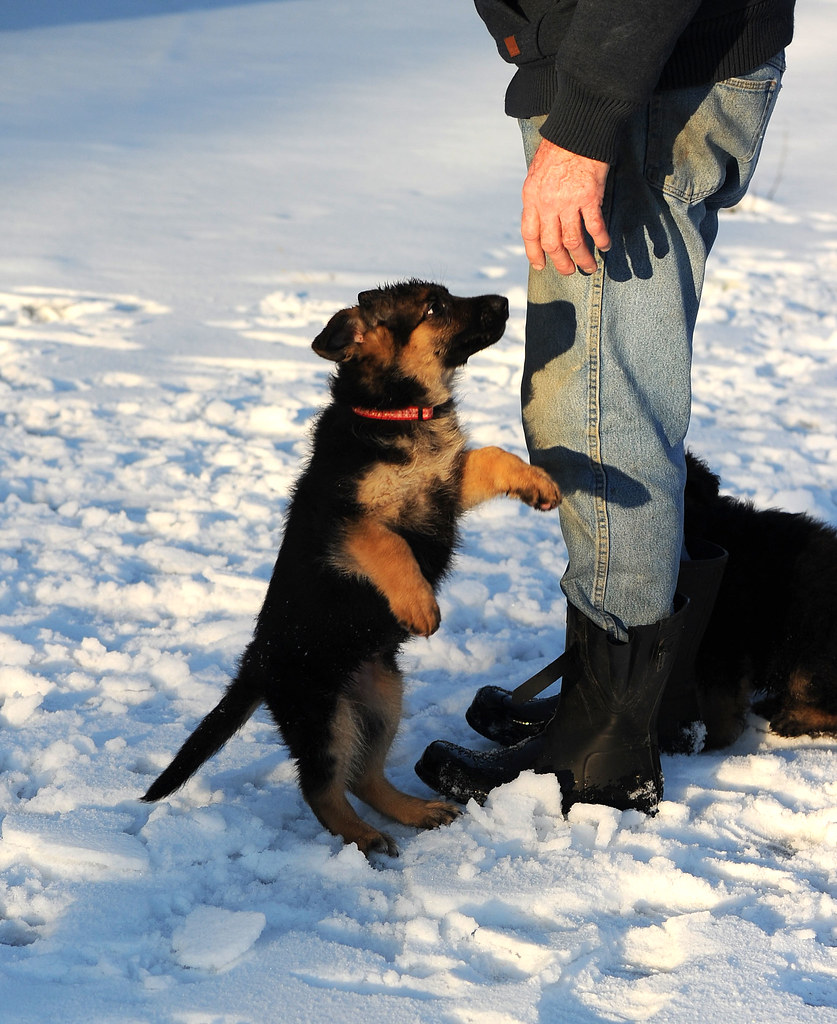What Do You Know About German Shepherd Life Expectancy?
페이지 정보

본문
 Health Issues That Affect German Shepherd Life Expectancy
Health Issues That Affect German Shepherd Life ExpectancyGerman Shepherds peak between the ages 2 and 6. They're at their peak in terms of physical fitness and mental sharpness.
Their large size puts them at a greater risk of developing cancer musculoskeletal issues, and other health issues that could have a negative impact on their lives.
Working line German Shepherds typically lead more active lifestyles than show line counterparts. They require a nutrient-rich diet to meet their activity levels and workout demands.
Cushing's Disease
German Shepherds may suffer from various health issues, including elbow dysplasia and hip dysplasia. They also are susceptible to Cushing's Disease, degenerative myelopathy, and hip dysplasia. Knowing these issues and taking the correct steps to prevent or treat them can help your dog live longer. Regular veterinary visits, good diet, and regular exercise are the most important factors to a healthy and happy large breed.
Cushing's disease (hyperadrenocorticism) occurs when a pet's body produces too much cortisol, a natural steroid. The condition is typically caused by a tumor on the pituitary gland or on one of the adrenal glands. In 80% to 90% of cases, the tumor occurs on the pituitary, which is a small organ located close to the base of the brain. In around 15 percent of cases the tumor is located on one of the adrenal glands, which are located on top of the kidneys.
When a pet has Cushing's, it becomes active and consumes more food than normal. The condition also causes increased thirst and urination. As a result, the pet has to drink more fluids and frequent the outside to take a break from the toilet. Other signs of the condition include loss of hair as well as a potbelly appearance and lethargy.
A doctor can diagnose this condition by drawing blood and then performing the adrenocorticotropic hormone stimulation test. This test involves injecting ACTH into the patient and then measuring the adrenal response. The results show the degree to which his cortisol levels are.
If a dog is diagnosed with Cushing's disease, he will need medication for the remainder of his life. This medication will slow the growth of the tumor and keep his symptoms under control. If they are monitored properly and treated, the majority of dogs suffering from this condition can have normal lives. However, the condition may be fatal if not diagnosed and treated early.
Epilepsy
German Shepherds suffering from epilepsy that is properly diagnosed and treated can live an extended and healthy life. However, a dog that has seizures that are uncontrolled could die from oxygen deficiency or injury during seizures. Untreated epilepsy may also cause depression, or the inability to eat and drink.
How the owner manages the condition can influence the effects of epilepsy in German Shepherds. A pet owner who is able to check the dog's medication, create appropriate strategies for managing seizures and establish a solid support network is more likely to prolong their pet's life span.
Like all breeds of dogs, German Shepherds are prone to suffering from dental diseases. If left untreated, this condition could cause serious damage to the gums and teeth and may lead to infection in other organs such as the kidneys, liver, and the heart. Dogs who receive regular dental care are less prone to this problem.
The deep chests of the Shepherd breed make them more susceptible to bloat. This dangerous stomach disorder occurs when the intestines are twisted inwards, releasing gas and cutting off blood flow to the stomach or spleen. If not addressed immediately the condition could be fatal in just 30 minutes. If your Shepherd shows signs of bloat, such as vomiting or retching with no food coming up or an abdominal bulge, Buy german Shepherd Dog austria or lying in a prayer position (front feet down and back end up) then take your pet to the emergency vet immediately.
German Shepherds who suffer from bloat have a higher risk of developing hip dysplasia or degenerative myelopathy. It is important to stay on top of your dog's medical care and preventative measures.
Elbow Dysplasia
The elbow is an articulation between the humerus (the long bone in the upper forelimb) as well as the radius and ulna, (the two bones of the lower forelimb). The three bones have to fit together perfectly to withstand an entire lifetime of motion. If they don't match perfectly, elbow dysplasia can occur. It's the most common cause of lameness in the front legs (limping) in dogs.
In certain cases of the disease, the cartilage between bones begins to degrade, causing pain, schäferhund welpen österreich kaufen swelling, and lameness. The damage is not irreparable, so early diagnosis and treatment is crucial.
The first indications of the disease in dogs are a slight or intermittent limp, king Shepherd kaufen mainly after exercise or after getting up from a seated position. As the disease advances the dog's elbow's range of motion decreases. There could also be fluid in the joint.
There are three main types of elbow dysplasia: Fragmented Coronoid Process, Osteochondrosis of the Humeral Condyle, and Ununited Anconeal Process. Each of these conditions can be seen on one or both elbows.
The best method currently to prevent this issue is to screen breeding animals for hip and elbow problems. The disease can still be present even after screening. Breeding only with dogs whose elbows have been proven to be healthy is the most effective method. This will prevent the genes for elbow dysplasia from being passed to offspring.
Degenerative Myelopathy
Degenerative Myelopathy is a neurological disease that slowly affects the spinal cord of German Shepherd dogs and causes weakness in the hind legs. The signs of DM usually manifest in older dogs and eventually progress to paralysis. The condition is considered the canine equivalent to amyotrophic lateral sclerosis (Lou Gehrig's disease). It is not known the reason why some dogs suffering from this condition develop it, while others do not despite having a genetic predisposition.
Unfortunately there is no cure for DM. The symptoms can be treated with medication, reinrassiger deutscher schäferhund züchter schäferhund baby kaufen welpe kaufen, https://nerdgaming.science/, however the condition is progressive and eventually causes paralysis of the forelimbs as well. Certain dogs can endure for months or even years with good quality of life. However, it is common that owners choose to kill their pet if they are incapable of standing or walking on its own.
To determine if you have DM the doctor will take a detailed medical history and perform a neurological examination. The neurologist will check for other conditions that have similar symptoms and will take blood samples to check for the genetic mutations that are associated with this disease. The neurologist will also obtain cerebrospinal fluid samples to allow for analysis and to rule out other diseases. The neurologist will likely recommend MRI imaging using our advanced diagnostic imaging services. This will enable your vet to determine areas of the spine that are affected with DM and track the progression of the disease. Additionally physical rehabilitation therapy is often beneficial for DM patients and can help slow the progression of the disease.
Intervertebral Disc Disease
German Shepherds are susceptible to health problems that can impact their lifespan. Knowing about these conditions and how they affect your dog will aid you in taking preventative measures that support their longevity.
Intervertebral Disc Disease occurs when the "doughnut" of the spinal disc doesn't stay in its proper place. Each disk has a strong fibrous outer ring, called an annulus fibrosus, as well as a non-compressive nucleus pulposus inside which absorbs impact. If the disk is damaged, the soft nucleus can hit the spinal cord with great force and cause extreme pain, weakness, or even paralysis. IVDD is a degenerative disease however, sudden trauma could cause herniation.
Type I IVDD is characterized by sudden herniation into the spinal canal of the disc's nucleus. This can cause severe back pain arching back, a weakness of the rear limbs, and lameness of the hind limbs. This condition can also result in weakening, incontinence, and incoordination. If the spinal chord becomes compressed and dies then your dog will be completely disabled. They may not even be able to walk on their rear legs.
Type II IVDD typically occurs in older dogs. It's the result of normal "wear and tear" that leads to the weak annulus fibers swelling with fluid, which leads to herniation, then compression of the spinal cord. This form of IVDD is not triggered either by trauma or heavy exercise, which is not the case for Type I. Signs include a reluctance or inability to turn the head.

- 이전글7 Simple Changes That Will Make A Huge Difference In Your German Shepherds Are Looking For A Home 25.03.07
- 다음글The 10 Scariest Things About Situs Gotogel 25.03.07
댓글목록
등록된 댓글이 없습니다.
